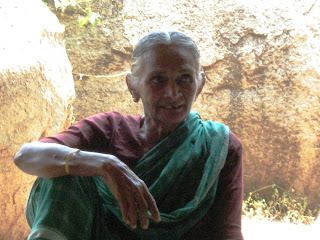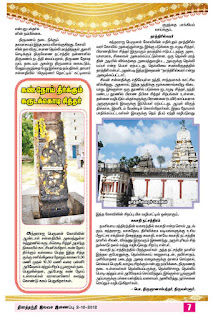 |
| Standing outside the Poondi Madha Basilica |
I had the grace of visiting the Poondi Madha Basilica near Thanjavur recently. It was a totally unplanned visit. We were passing by the highway when we saw the Board reading "Way to Poondi Madha Basilica". Having heard so much about the grace of The Poondi Madha, and how she has created many miracles in the lives of her devotees, we quickly decided to detour and reach the Basilica. It was one pm in the afternoon and the church was relatively empty. The white tower of the Basilica stood out from a distance, inviting those eager to visit the Basilica and bask in the compassion of the Divine Mother.
 |
| Rows of Statues of Saints line the path to the Basilica |
We walked slowly through the lane lined with statues of Saints, into the gates guarded by angels. There is a huge notice board giving bus and train routes from various parts of India to the Basilica along with timings. Rooms are available for those coming from other places to stay and pray at the church.
History of the Poondi Madha Basilica:
- The original dome where the miraculous statue of Our Lady of Poondi is placed was built during 1714 - 1718 by Rev.Fr. Constantine Joseph Beschi. Tamilnadu knows him by the name of "Veeramamunivar" (வீரமாமுனிவர்) . An Italian Missionary, he mastered the Tamil language and has created several literary works that earned him the title of "Father of Tamil Prose". His "Thembaavani" and "Paramartha Guru Kadhai" are famous even today. The Tamilnadu Government has honoured him by placing his statue on the Marina Beach.
- In 1956, the then Parish Priest, Rev. Fr. Lourdes Xavier, whose tomb is seen at the entrance of the chapel, where people stop by and pray, wanted to rebuild the dome which was in a state of damage, requiring immediate attention. Not having sufficient funds to carry out the repairs, he fasted and prayed to the Holy Mother for 15 days. On the 15th day morning, he heard an inner voice and told the people that the front portion of the church would come down on its own by that afternoon. Exactly as he said, the building collapsed. This happened on 22nd November, 1956 and the reconstruction was completed by 2nd May 1964.
- The Holy Mother appeared to Bernadette in 1858 in Lourdes in France. Statues of Our Lady of Lourdes was sent to different parts of the World. Out of the three statues that came to India, one was brought to and remains in the Poondi Shrine. This statue is so unique, that while looking at it, one gets a feeling of looking at a live person.
- Since the time the statue was installed in the church, a mysterious brightness has been filling up the entire church during night time. People started special devotion to Our Lady and several miracles started happening here, which continue till day!
- A small piece of the original cross of Jesus was brought to the church by Rev.Fr.Rayappa in 1976. One can see this below the Statue of the Holy Mother.
 |
| Relic of the Original Cross (Photo Courtesy: Poondi Matha Basilica) |
- Several thousands of devotees throng the Poondi Madha Basilica on September 8th every year, the Birthday of Our Holy Mother. A procession is taken out in an ornamental chariot which is witnessed by people irrespective of caste and religion, who gather and pray here on this auspicious day.
- The church has a membership scheme whereby one can pay as less as Rs.100 as a monthly subscription. When the amount reaches Rs.5000/- the person becomes a life member and the person is remembered and prayed during every mass offered in the shrine.
We knelt down and prayed at the altar. Looking at the Holy Mother who looked skywards in prayer, seemed to take away our burdens and lighten our hearts. After praying we went across the church, to the Museum, which houses all the articles and artifacts given by devotees whose prayers have been answered. From parts of the body in silver for diseases and ailments cured, to stethoscopes, pens, gold and silver jewellery, house models, several articles have been donated with devotion and gratitude. Letters thanking the Holy Mother for Her grace in their lives are attached to the artifacts and bear testimony to the various miracles that happen here every day.
There is also a Depot in the Church complex which sells various items like pictures, idols, books, CDs, Calendars, Bibles, Rosaries etc. Several people are seen here purchasing articles of their choice. Holy oil and water are also available in this depot. Since it was past 2 pm, we moved out towards the restaurant opposite to the church. On our way out, several geese cackled and played in the lawns outside. We stood for a while, taking in the beautiful surroundings.
Where is Poondi Madha Basilica:
The Poondi Madha Basilica is in Alamelupuram Poondi near Thirukattupalli in Thanjavur District of Tamilnadu.
Nearest Airport: Trichy - 45 kms
Nearest Railway Stations: - Budalur - 18 kms, Thanjavur - 35 kms, Trichy - 35 kms
Bus: Several State and Private Buses are available from Chennai, Vailankanni, Kumbakonam, Thanjavur, Pudukottai, Trichy, Kallanai, Lalgudi, Pullambadi and Perambalur.
Contact Details: 91-4362-280422
Address:
The Rector,
Poondi Madha Basilica,
Poondi, Thirukattupalli Via,
Thanjavur Pin: 613105
Mass Timings:
Weekdays - 6 am, 11.15 am and 5.15 pm
First and Third Saturday of Every Month - 6 am, 9.30 am, 11.15 am, 5.15 pm
First Saturday - Prayer Service followed by Mass - 9 pm and 12 pm
Sundays - 6 am, 8.30 am, 11.15 am, 12.30 pm (English) and 5.15 pm
For further information on the Basilica check out the official website of the shrine here
 |
| Main Altar (Photo Courtesy: Poondi Madha Basilica) |
If you happen to be at this part of the world, do stop by to pray here. Peace of mind and relief guaranteed!
Aalayam Kanden wishes its readers a Merry Christmas and a Very Happy and Prosperous 2012!
Acknowledgements:
Sincere thanks to Mr. Ajoy Leo whose video of the Holy Mother has been used in this post, and to the Poondi Madha Basilica for pictures of the Main Altar and the Relic of the Original Cross.














































































































































